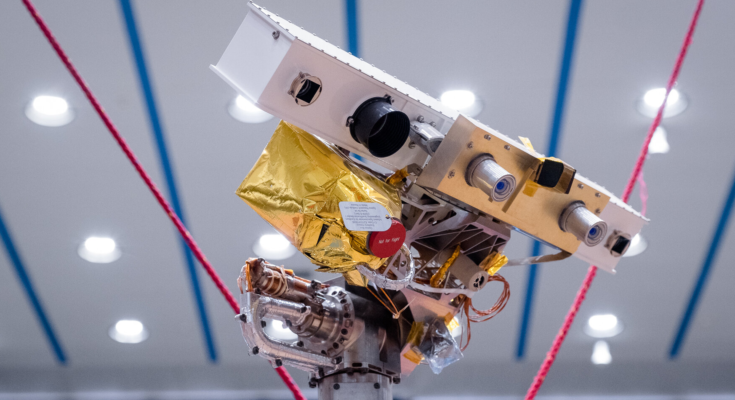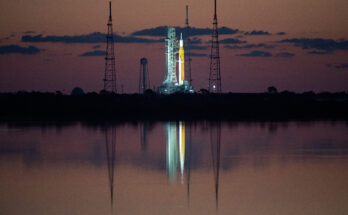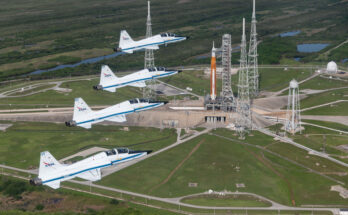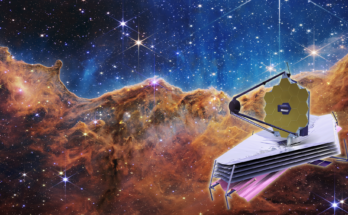Humans have been active in space exploration for more than six decades since the former Soviet Union and the United States pioneered our species into space in the late 1950s.
Space exploration as we have known it during that time is being transformed today with more economic opportunities opening up. So, we now can see totally new terms like Space Industry, and Space Economy being used more frequently – and not just in the developed countries.
Space Industry and Space Economy?
Wikipedia defines Space Industry as economic activities related to manufacturing components that go into Earth’s orbit or beyond, delivering them to those regions, and related services.
So, space industry is limited to physical manufacturing of items that goes to space. But with new economic activities like Space Tourism and Deep Space mining being added to those economic activities, the term Space Economy is being used in a much broader sense.
According to the Statista website, the total turnover of Space Economy was 423.8 billion U.S. dollars in 2019. It clearly indicates how big this business already is.
Even though these terms may be new to some of us, space related economic activities actually started with the beginning of the satellite era. The launch of Sputnik 1 on 4th October 1957 can be defined as the beginning of space economy.
Apart from the military use, most of the Satellites sent to space had some economic or business component behind it. At the same time, all the rockets that have been used in space exploration and all the vehicles used in space transportation also can be included in space industry or the space economy as each and every part that have been used in the development of these massive units have an economically important process behind them.
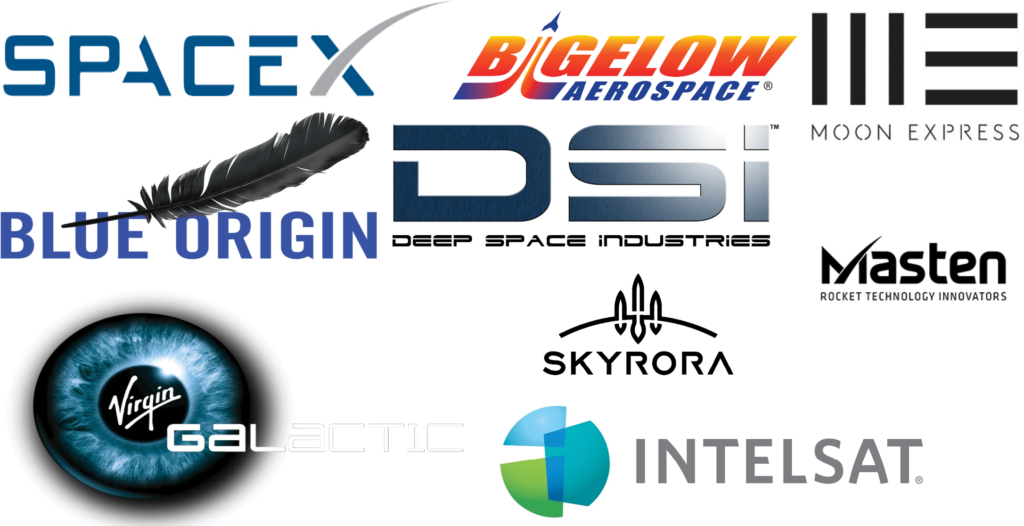
In earlier days most of those launches and processes were carried out mostly by government agencies. But now the things have changed dramatically, and many private companies have begun their involvement in this industry with a massive competition to deliver the needs in space exploration related activities.
According to Statista website Lockheed Martin, Airbus Raytheon Technologies and Boeing are the four leading companies in Space Industry. They had secured over 50 billion USD each in revenues from aerospace related activities .
Space Economy Landscape is Changing
More interestingly, there are many new avenues that are being opened up in Space Economy. Those have created a vast pool of opportunities for anyone in the world.
So,understanding these opportunities and getting ready to grab them is in essential thing if we are to make our mark in future Space Economy.
Given below are some of those new avenues in modern day space economy.
Space Tourism – A decade back the concept of space tourism was merely science fiction. But in recent months, we saw several companies, namely Space X, Blue origin, Virgin Galactic taking tourists in to the space. In the most recent trip,Space X took four civilians in a three-day space trip onboard their Crew Dragon space vehicle. They all paid an undisclosed, high amount for the trip. So, the year 2021 will go in the history books as the year that began commercial space tourism.
Asteroid Mining – Asteroid mining is the process of reaching asteroids or any other objects in the solar system, land on them and get back to earth with samples obtained from the object. Even though this is still a hypothetical process, few recent projects by Japan Space Agency JAXA have been able to make this a reality. Two recent projects Hyabusa and Hyabusa 2 have been able to return tiny amounts of samples from near earth asteroids. And one on-going project OSIRIS-Rex is expected to return to earth on 2023 with more than 60 grams of samples from the Asteroid Bennu, a near earth asteroid that flew past earth in 2017. Scientists predict this asteroid mining would become a lucrative business in near future with companies hunting for minerals like Gold, Cobalt, Iron, Manganese, Molybdenum, Nickel, Osmium, Palladium, Platinum, Rhenium, Rhodium, Ruthenium and Tungsten.
Space Manufacturing – Research carried out at space stations have proven that there are products that can be manufactured in the orbital space environment which are impossible to manufacture under the gravity on earth. So, there will be opportunities in future to manufacture some innovative products commercially in space environment.
Space-for-earth products – This is the more conventional form of space Industry that we are familiar with. These include goods or services produced in space for use on earth. Telecommunication Services, Mapping Services, and defense related services are some prime examples.
Do we have a Space in Space among the Giants in the business?
By mid 2021, there are 72 different government space agencies functioning around the world. Just 14 of them have the launch capability.
Which means most of these space agencies are not major operators but they are doing research and engaging in various possible ways in space science and astronomy.
Even developing countries like Myanmar and Bangladesh already have their own agencies or organizations that are responsible for Space Science and related fields. Bangladesh began their Space Research and Remote Sensing Organization way back in 1980. For many years they had the plan of establishing themselves as a country in Space Industry and space science.
When we look at these countries, it is obvious that a country does not need to have a massive space agency or space programme to begin our own research wing in space science. Around 2009, there were some media report that Sri Lanka had planned its own research wing with the name “Sri Lanka Aeronautics and Space Agency” but we didn’t heard of it ever since.
Is it worth investing in Space Science as a medium income country?
We asked this question from a Sri Lankan born Space Engineer Mahilal de Silva who is currently leading a mechanical engineering team in charge of ExoMars rover project by European Space Agency(ESA).
“Most certainly, in my opinion space research/exploration is an ideal investment for a medium scale developing country, where it will enable to create a massive space exploration community within the country. Investing in Space will enable us to build research centers (ex: Planet Mars research centers), educational institutions, to create specialized skilled jobs, introduce new technologies and bring back revenue to the country and also this will widen the international relationships via technological knowledge share.”

There are big challenges ahead!!
Yes, being a country with limited pool of physical, human and technological resources on space science and astronomy, it is a big task for Sri Lanka to establish itself in the space industry. But we have to start somewhere, and keep up with other countries in this fast changing sector.
Challange No 1 – Human Resources
The first challenge towards a Sri Lankan Space Science and Astronomy research sector and a space industry is to produce much needed human resources. One of the best ways to jump start this is to get the help and guidance from Sri Lankan experts like Dr. Sarath Gunapala, Eng. Mahilal de Silva and astronomer Prof. Chandra Wickramasinghe in empowering Sri Lankans with the latest knowledge in these fields.
At the same time, we should start communicating the basics of space science to the young generation. This can be promoted as an extra-curricular activity as some schools already have astronomy societies. Recently, undergraduates at some universities like Moratuwa and Sri Jayawardenapura have started chapters of Students for the Exploration and Development of Space (SEDS), a worldwide movement of youth interested in space exploration and technologies. So, we should capitalize on these initiatives and work towards a broader goal of building up a good human resource pool for the future of space industry in Sri Lanka.
Indeed, our University system can play a lead role in developing human resources needed for the space economy and space industries.
But are we prepared for this? Is our Sri Lankan University system capable of managing this issue and produce a good quality pool of human resources?
This is one of the main questions we should have answered if we are to move ahead with securing a good pool of human resources needed for a space economy and a space industry.
Challenge No 2 – It’s an expensive sector
Most of the research and development processes involving space science are highly expensive, or are they?
Eng. Mahilal had these to say,
“I would say the capital investment will be a considerable amount to start with, conceptual design, planning, site selection, commissioning and getting the correct expertise will be a challenge, but in the long run it will not be an enormous cost.”
“Most of the developed countries balance out their budgets by allocating a certain percentage for space exploration. Also, they encourage the private sector by introducing a number of incentives and have regular discussions to understand the space demands i.e. discuss about the climate change/earthly impacts and how to mitigate by improving the space sector research. “
Challenge No 3 –Technology Transfer
Space Industry and Space science as a whole is a sector that is developing rapidly. Many technologies used in these sectors are new. And for a country like Sri Lanka acquiring these technologies would pose budgetary challenges.
But if we plan wisely there will be whole lot of opportunities where we can get the needed technological knowledge absorbed to the local talent. Specially the Sri Lankan talent who are working in these fields would be a great initiative.
At the same time technology transfer through bilateral agreements also would be a great way to empower our talent with this latest knowledge. And while absorbing those technologies from other sources we have to establish a research facility through which we have to develop our own technologies that can be used in these areas.
Challenge Number 4 – Public perception towards space science
Most of the general public tend to think the Space Science is for wealthy nations and countries like ours have to stay out of it. But if we are to establish ourselves in the space industry, we have to change this and get the public interested.
In doing that, science journalism and science communication plays a key role.
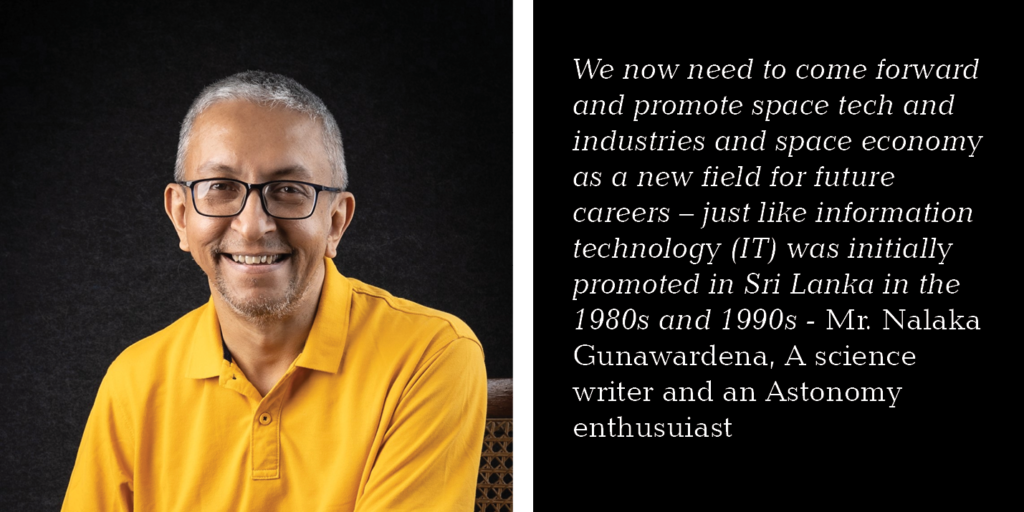
“There is considerable enthusiasm among our children and youth in studying astronomy and space and some of them want to pursue careers in space related fields. Right now, they cannot do this unless they leave the country and go to Europe or USA that welcomes very bright young people with talent and skills. Amateur astronomy enthusiasts have kept public interest in this sector going for several decades but we now need to step it up and promote space tech and industries and space economy as a new field for future careers – just like information technology (IT) was initially promoted in Sri Lanka in the 1980s and 1990s,” says science writer Nalaka Gunawardene who has been writing about space related issues for many years in the media and online.
It’s not too late to start our journey in space industry and make our mark in modern day space economy. The key to success is in identifying the opportunities we have in these sectors, and make a realistic plan according to the resources and strengths we have as a country and setting our targets.
The Fourth Industrial Revolution is already upon us, and space technology will play a major role in the coming years and decades. As a country it’s high time to look in to this seriously and get our agenda right.
Featured Image – Stereo cameras at the top of the ExoMars rover’s mast – NavCam – allows the GTM to ‘see’ in three dimensions and identify the rocks and slopes ahead. This is one of the cameras that guide the rover through safe paths and help avoid hazards. Source – ESA

